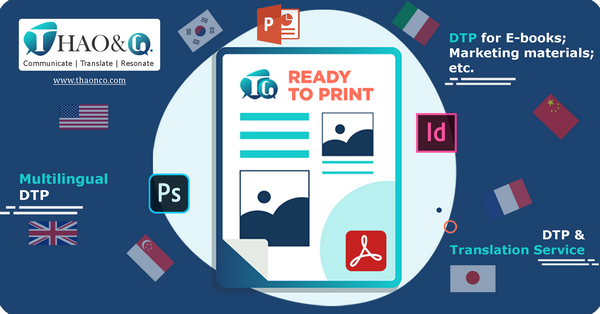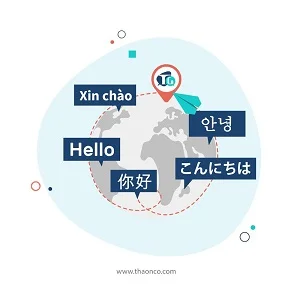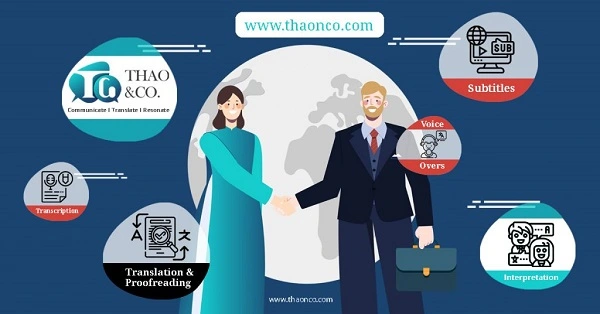Desktop Publishing (DTP) is known as the use of dedicated computer programs to translate documents with complex structures of text and visual elements. So what is Multilingual DTP or Multi-language DTP? What role does it play in translation and how is it different from standard DTP?
Multilingual DTP is the processing of texts, images, and other elements before entering the translated document into the printing and publishing stages. This task includes font adjustment, text alignment, processing images, charts, and graphs, as well as maintaining the uniformity between the original and the translation with the goal of preserving the original document’s format.
Multilingual DTP is often used in international projects where documents need to be translated into many different languages in order to target different audiences. Documents requiring Multi-language DTP may include:

It’s crucial for foreign enterprises to provide customers with multilingual instruction manuals so that they can understand and use their products effectively.
The examples above are just a few common cases where Multi-language DTP is required. In reality, there may be many other document types that require multi-language DTP, depending on the particular requests and nature of each individual project.
Translation and Multi-language DTP each come with their own unique challenges. Both translation and multi-language DTP involve more than just translating text and copying the original formatting using available software.
1. Text length limits: Each language has its own grammatical structure, vocabulary, and presentation rules to follow. Translators must therefore closely monitor text length to prevent major discrepancies between the translated and original material, laying the groundwork for a more seamless DTP process.
2. Knowledgeable and seasoned translators: The translation process requires translators to have not only extensive experience but also a deep understanding of both the linguistic nuances and cultural context of the target language. This helps ensure the message and content are conveyed accurately and effectively.
3. Context of the text: Since each language has its distinct linguistic and grammar characteristics, sentences and words can be interpreted in different layers of meaning. Therefore, context is crucial in enabling translators to comprehend and accurately translate the intended meaning.
4. Terminology and measurement units: Fields such as engineering, medicine, construction, and mechanics have diverse specialized terminologies, and different regions have different measurement systems. Translators need to be well-versed in these subject areas in order to properly translate or convert units of measurement, ensuring accuracy and consistency in the translated document.
5. Lack of equivalents in the target language: Naturally, there are instances where an exact equivalent word or phrase cannot be found in the target language to allow for a precise translation. In these cases, translators must find an alternative expression and determine whether to describe the term directly or indirectly so that readers can grasp the meaning, while still maintaining an appropriate length.

1. Use of suitable fonts: When working across multiple languages, each has its own character set, structure, and nature to consider. Sometimes, the target language requires a special font, or the original font does not support the target language, as with translating English to Chinese, Korean, or Arabic. DTP specialists then need to find a font with similar nuances to maintain the style and spirit of the original design.
2. Length alignment and text organization: The language can affect the desktop publishing process – specifically, the text length directly impacts the layout of elements on the page. For example, when translating from English to Vietnamese, the word count may increase between 15% to 30% depending on the document type. This can alter the page layout, requiring DTP specialists to adjust text length, alignment, and spacing between components to ensure the final product maintains the format of the original.
3. Understanding of multilingual presentation: Multilingual DTP must also account for charts, graphs, tables, special symbols, and other graphical elements. It’s crucial for DTP experts to have substantial experience and work closely with translators to restructure the layout of text and images in an accurate and culturally appropriate way for the target language.
4. Expertise in a wide array of design tools: To effectively execute visual-related tasks, Multilingual DTP specialists are expected to be skilled with computer-based graphic design software such as Adobe InDesign, Illustrator, Photoshop, CorelDRAW, and Microsoft Office Suite.
5. Knowledge in multidisciplinary design: In addition to expertly using these design programs, DTP specialists must have extensive experience and a deep understanding of layout principles across various fields. They also need the ability to manage multiple file formats like PDF, EPS, and AI, on top of document printing and production processes.
Understanding the difficulties and challenges you face, Thao & Co.‘s text and document translation paired with DTP services aims to be a helpful partner. We strive to deliver translations that are accurate and appealing down to every detail.
Organizing and re-designing the layout of the document after adapting the language is a crucial part of the translation process to ensure the aesthetic of the target text, specifically:
1. Ensuring accurate content and message presentation: Multilingual DTP ensures that the text is fully finalized before reaching consumers. Arranging and redesigning the document layout based on the translated content as well as linguistic and cultural nuances helps prevent misinterpretation and confusion for readers.
2. Maintaining the consistency and professionalism of the content: Both desktop publishing in general and Multi-language DTP specifically aim to maintain consistent formatting between the translated and original documents. Designing, aligning, and organizing appropriate layouts tailored to each language and culture lends a professional look. It also enhances the readability, clarity, and visual appeal of the document.
3. Aiming toward the global market: In today’s globalized economy, Multilingual DTP is the key to creating marketing materials, instruction manuals, and specialized documents in many different languages. The ultimate goal is to expand companies’ reach and open up new business opportunities.
4. Delivering a better experience: Documents undergoing Multilingual DTP process will provide the target audience with greater ease of use and a positive experience.
The immense value and indispensable role of Multilingual DTP in translation is truly undeniable. With the help of Multi-language DTP, you can expand business opportunities and customer engagement, while conveying professionalism and passion for your products and services.
In summary, we’ve explored the vital importance of Multi-language DTP in the translation process. As the process of adapting content into multiple languages while tailoring formatting to each linguistic and cultural context, Multilingual DTP serves as a vital tool for bridging the gap between companies and prospective customers globally. Among the reliable translation agencies, Thao & Co. stands out as a strong option.

Thao & Co. offers not only high-quality text and document translation services for every industry but also premier multilingual DTP capabilities. Here are reasons to choose Thao & Co. for translation and multilingual DTP services:
Understanding the importance of Multi-language DTP in translation, Thao & Co. is sure to be the leading choice, delivering exceptional text and document translation plus premier multilingual DTP to elevate your projects and campaigns. Please leave your information on our Get a Quote page for prompt assistance!